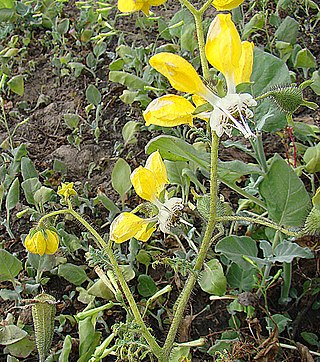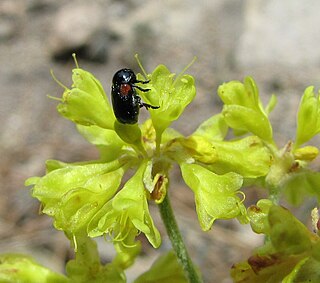
Geotrupes is a genus of earth-boring scarab beetles in the family Geotrupidae. There are at least 30 described species in Geotrupes.

Bathybates hornii is a species of fish in the family Cichlidae. It is endemic to Lake Tanganyika where it forms schools and feeds mainly on clupeids. This species is apparently rather rare. It is little known and it is normally recorded from deep water during the day and moves towards the shorelines at night. The identity of the person honoured in this fish's specific name is uncertain but it is likely to be either, or both, of the Horn brothers, Adolf or Albin, who explored German East Africa and collected specimens for the Vienna Museum where the describer Franz Steindachner was curator of fishes.
Nasa hornii is a species of plant in the Loasaceae family. It is endemic to Ecuador. Its natural habitat is subtropical or tropical moist montane forests.

Nasa is a genus of plants in the family Loasaceae containing over 100 known species, all of which are found in South America with the exception of two species endemic to Central America. They are common in submontane to montane environments.

Endomychidae, or handsome fungus beetles, is a family of beetles with representatives found in all biogeographic realms. There are around 120 genera and 1300 species. The family was established based on the type genus Endomychus, a genus erected in 1795 by Panzer which was applied to a species that Linnaeus called Chrysomela coccinea. As the common name suggests, Endomychidae feed on fungi. Crowson, in his influential treatment of the beetles, placed the family within the Cucujoidea. They have a tarsal formal of 4-4-4 or 3-3-3 and the wings lack a closed radial cell. The second antennal segment has a sensory appendage that is as long as the third antennal segment. The family has also been grouped with the Coccinellidae in a group called the Trimera for having pseudotrimerous tarsi. A 2015 molecular phylogeny study found that the Cucujoidea were found to be non-monophyletic and the Endomychidae was refined with the removal of the Anamorphinae from within the family and elevated to the status of a full family, Anamorphidae. Mycetaeinae and Eupsilobiinae were also found not to belong within the clades of the core Endomychidae, and likewise reclassified into the families Mycetaeidae and Eupsilobiidae.

Euceratocerus is a genus of death-watch beetles in the family Ptinidae. There are four described species in Euceratocerus.

Dicerca is a genus of beetles in the family Buprestidae. It contains the following species:
Saperda horni is a species of beetle in the family Cerambycidae. It was described by Joutel in 1902. It is known from Canada and the United States. The species name is often misspelled as hornii.

Saxinis is a genus of case-bearing leaf beetles in the family Chrysomelidae. There are at least 10 described species in Saxinis.
Neoscutopterus hornii is a species of predaceous diving beetle in the family Dytiscidae. It is found in North America.
Phyllophaga hornii is a species of May beetle or junebug in the family Scarabaeidae. It is found in North America.

Dineutus hornii is a species of whirligig beetle in the family Gyrinidae. It is found in North America.
Bolbelasmus hornii is a species of earth-boring scarab beetle in the family Geotrupidae. It is found in North America.

Mycetina is a genus of handsome fungus beetles in the family Endomychidae. There are about 11 described species in Mycetina.
Geotrupes hornii, or Horn's earth boring beetle, is a species of earth-boring scarab beetle in the family Geotrupidae. It is found in the northeastern United States and southeastern Canada, most commonly between the months of June and September, peaking in August.
Dicerca hornii is a species of metallic wood-boring beetle in the family Buprestidae. It is found in North America.

Macrovelia is a genus of macroveliid shore bugs in the family Macroveliidae. There is one described species in Macrovelia, M. hornii. It prefers shaded areas and overwinters as an adult.
Nemadus hornii is a species of small carrion beetle in the family Leiodidae. It is found in North America.
Listronotus hornii is a species of underwater weevil in the beetle family Curculionidae.

Elacholoma is a genus of flowering plants belonging to the family Phrymaceae.











